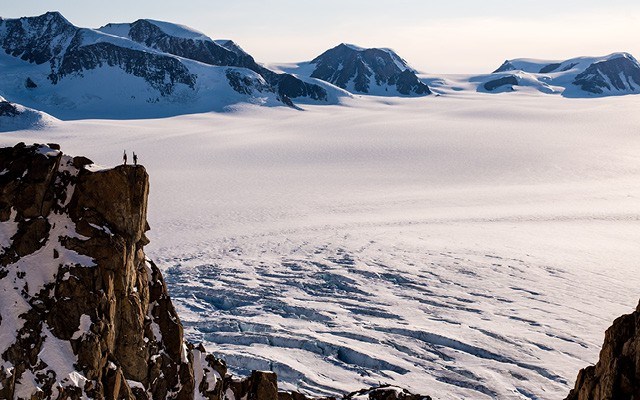Banff, New York, Toronto, the U.K. — it's been a busy spell for the Switchback Entertainment crew. Come film season, you can count on something new and ambitious from Mike Douglas and company and this year is no exception. Not only did they premiere their climate-focused ski film Guilt Trip in these locales, but had attendees in each geeking out over a Google Expeditions-born virtual reality (VR) experience before they'd even reached their seats.
"The VR basically functions like a DVD extra, a behind-the-scenes collateral to the film," says director Anthony Bonello.
Recorded on a small Google VR camera with two overlapping fisheye lenses, the stereoscopic technology collects a 3-D image; people then experience the 360-degree immersive VR on a mobile device lodged in a cardboard heads-up display resembling a pair of ski goggles. These videos are live online and can be watched on your mobile, where you get the 360-degree view simply by moving your device. Even better, teachers can download a Google Expeditions app and integrate the VR into their lessons.
Beyond the tech, you might want to know what this VR is accessorizing. The film's premise is straightforward: the only thing greater than these skiers' desires to claim a first descent on Mt. Forel, Greenland's second highest peak, is the size of their carbon footprint to get there. To assuage their guilt, they bring along renowned glaciologist, Alun Hubbard, whose hypothesis about meltwater running off a hard-ice layer within the Greenland ice cap, if proven, could rewrite projections of global sea-level rise. The expedition is put in question when they arrive to discover their objective is beyond the range of all available aircraft.
The film opens with a bang (I'll leave it at that) and the melting starts early on an overnight dog-sled trip. It then segues to the aircraft issue, which finds the group dropped not on the icecap they desire, but an outlet glacier 30 kilometres short and 1,000 vertical metres shy of where Hubbard's science plan — drilling several ice cores — is meant to unfold. This means they'll have to move a literal ton of gear up the glacier and onto the accumulation zone of the ice cap near Forel. But for the time being they settle in and make the best of it.
The skiing, in ice-lined couloirs, will grip you, but the setting is indisputably spectacular. Unfortunately, it's also "hot, very hot" on the south-facing slopes. And the heat has another consequence: they're camped on a moving glacier, and crevasses soon open beneath their tents. "You become desensitized and have to make light of it," says Bonello, "because someone could easily have fallen into one in our 'safe' camp, which actually moved 16 metres in a week — that's the speed of an outflow glacier."
While crevasses were the predominant safety issue, the biggest challenge from a filmmaking perspective, says Douglas, was "communicating science without dragging the film down into Boredomville. We still get diehards begging for music and ski porn, but our audience has generally matured and most appreciate our effort to bring more than thrills to a project. Also, climate-change documentaries are depressing. So instead of preaching to the choir without engaging anyone new, what we all wanted here was to open the discussion up to a new audience, and the best way to do that was have a little fun with it."
There's fun aplenty. A sequence with Hubbard's homemade drone is good humour — until it disappears. Something else they consciously tried to do was put aside the typical outdoor film formula of making everything look gnarly. "We signed up for adventure and expected to be cold and walking around on crevassed ice — we're camped on a moving glacier, so what else would we think?" says Douglas. "So we wanted to portray it that way."
In other words, they eschewed the grunts and agonized facial expressions of reality TV. "Sometimes to our detriment, but it keeps us authentic," says Bonello, who'd had the idea for a few years to link science with an expedition. "We're going to these remote places and we know our environmental footprint is huge. So... is there a way to spin this for a positive purpose? Is this a solution? No, but it's an opportunity to talk and learn form a person like Alun who's exceptionally knowledgeable about it."
Eventually, they strike out toward Mt. Forel, a 10-hour, 1,200 vertical-metre slog to a place where it's even more stark — huge, glacier-laden mountains, and nunatuks revealed by climate change poking from a flat ice cap. The trek is captured with a Bonello drone shot that brings scope and scale into perspective.
In the end, the goal was to make the vicissitudes of climate change in Greenland as visceral as possible and get people to actually engage, but there were other benefits, as noted by Douglas. "For me, the coolest thing was to completely disconnect from the world for two weeks. You just can't do that in normal life anymore — it was so refreshing."
Guilt Trip is showing along with The Highway as part of the Whistler Film Festival on Thursday, Dec. 1 at 6 p.m. and Sat. Dec. 3 at 5:30 p.m.
Leslie Anthony is a Whistler-based author, editor, biologist and bon vivant who has never met a mountain he didn't like.




